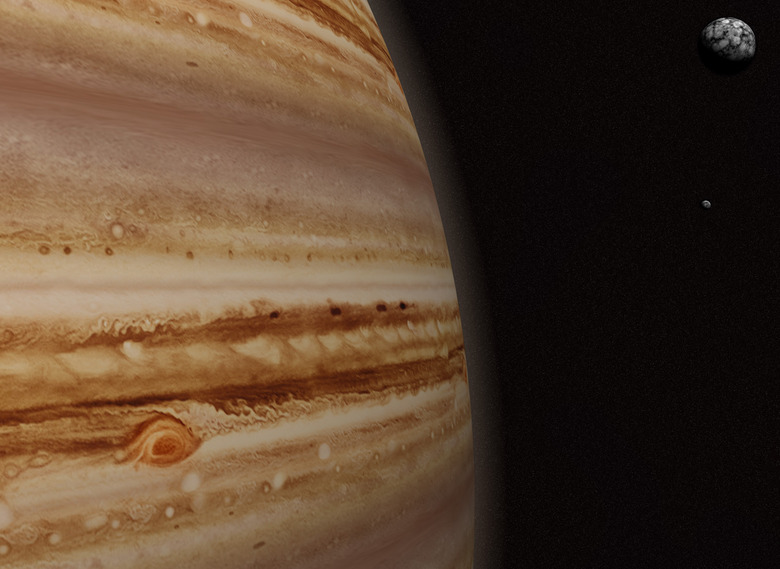What Are The Characteristics Of The Planet Jupiter?
The planet Jupiter, named after the Roman god (a derivative of the Greek god Zeus), is the largest of the Jovian Planets– also called the gas giant planets – and the fifth planet in our solar system. Astronomer Galileo Galilei's observations of Jupiter and its moons in 1610 helped provide important evidence for the heliocentric theory of planetary motion, since then space agencies and astronomers on Earth have studied the incredible planet for hundreds of years. Although this outer planet is hundreds of millions of miles from Earth at closest approach, it is still easily visible as a bright, colored point in the night sky.
Overview and Facts
Overview and Facts
The gas giant Jupiter is the largest planet in the solar system, more than 300 times more massive than Earth. Due to its enormous size and reflective clouds, Jupiter is the third brightest object in the night sky, after the moon and Venus.
At a distance of about 500 million miles from the sun, Jupiter orbits just outside the asteroid belt. Because of the large distance, one Jupiter year is equivalent to nearly 12 Earth years (over 4,300 Earth Days). From this distance, light from the sun takes over 40 minutes to reach Jupiter – compared to only 8 minutes of travel time to reach the Earth.
Chemical Composition
Chemical Composition
Like other gaseous planets, Jupiter lacks a solid, rocky surface. Instead, the planet is composed of gaseous layers that grow increasingly dense with greater depth. In fact, the weight is so intense that deep within Jupiter, hydrogen is compressed into a metallic liquid that conducts electricity. This liquid is the source of Jupiter's magnetic field. Chemically, Jupiter is 90 percent hydrogen and 10 percent helium, with trace amounts of ammonia and other substances that give the planet its vivid colors.
Jupiter's Rings
Jupiter's Rings
Although Saturn's rings are more well-known, Jupiter is also surrounded by flat rings of debris. Jupiter's ring system is smaller and closer to the planet than Saturn's and contains mostly small grains of rock and dust. Because these rings contain no ice, they are not brilliant and reflective like Saturn's rings, and thus were only discovered in 1979 by the Voyager 1 spacecraft.
Jupiter in the Solar System
Jupiter in the Solar System
Situated just beyond the asteroid belt that circles the inner terrestrial planets, Jupiter unintentionally protects many of the smaller rocky planets by interacting with rogue objects in the Solar System. Planets like Neptune and Uranus, while very large, are too far away to substantially influence the inner planets as much, but Jupiter deflects and redirects massive asteroids and comets very often.
The comet Shoemaker-Levy 9 is perhaps the most notable of these interactions. It was a large comet that passed so close to Jupiter, so that it was pulled apart by gravitational tidal forces. It broke apart into
Great Red Spot
Great Red Spot
Jupiter's entire visible surface is covered by clouds, many of which are composed of ammonia gas. These clouds are stretched into stripes by strong winds in the planet's atmosphere. Jupiter's Great Red Spot, a particularly notable red blotch in the southern hemisphere of the planet, is a massive, high-pressure storm that has been raging for more than 300 years. The Great Red Spot spans nearly one and a half the size of Earth in diameter.
Jupiter's Satellites
Jupiter's Satellites
More than 60 known satellites, or moons, orbit the planet Jupiter. Some satellites are very small and have temporary, chaotic orbits. Other satellites are large and stable, like the four moons discovered by Galileo: Io, Europa, Ganymede and Callisto. These moons are almost as large as planets, and have complex layered structures that resemble our own Earth. These Galilean Moons include the largest moon in the solar system, Ganymede, and the most volcanically active, Io.
TL;DR (Too Long; Didn't Read)
Ganymede is actually larger than the planet Mercury! While Europa and Io are very similar in size to Earth's moon.
Past and future space missions aim to investigate the geography of Jupiter's moons and search for liquid water or even life. The future Europa Clipper is planned for 2024, and it will attempt to interact and directly study the bodies of liquid detected beneath Europa's solid surface.
Images of Jupiter
Images of Jupiter
Throughout NASA Solar System Exploration programs, there have been many images taken of Jupiter's surface and moons from a variety of spacecraft. The more recent Juno Mission (launched in 2011), was a dedicated spacecraft to study Jupiter's atmosphere and the Galilean satellites. It took incredible photos, all of which are available for public use. Other flyby missions, like the earlier Galileo Spacecraft (launched in 1989), the Cassini Saturn craft (launched in 1997) and the Pluto New Horizons mission (launched in 2006) took wonderful images of Jupiter's surface, upper atmosphere, and moons. The Pioneer 10 spacecraft was the first mission to take closeup images of Jupiter in the early 1970s.
Cite This Article
MLA
MacIntosh, Mary. "What Are The Characteristics Of The Planet Jupiter?" sciencing.com, https://www.sciencing.com/characteristics-planet-jupiter-10000881/. 14 June 2023.
APA
MacIntosh, Mary. (2023, June 14). What Are The Characteristics Of The Planet Jupiter?. sciencing.com. Retrieved from https://www.sciencing.com/characteristics-planet-jupiter-10000881/
Chicago
MacIntosh, Mary. What Are The Characteristics Of The Planet Jupiter? last modified June 14, 2023. https://www.sciencing.com/characteristics-planet-jupiter-10000881/
